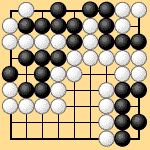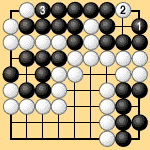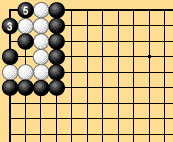 |
2.3.9 Special Positions
|
Dia. 2-23-1 is the famous Fujimura problem. This is in principle the
same as a bent four in the corner. After connecting on the upper edge,
Black can eliminate all ko threats, then capture White as in Dia.
2-23-2. In some cases, however, it will not be possible to eliminate
all ko threats, so White cannot be considered unconditionally dead. How
should these stones be removed? This is an important rules question.
|
 |
 |
| Dia. 2-23-1 |
Dia. 2-23-2 |
|
Dia. 2-24-1 is another very interesting problem. Black is of course
free to make the position a seki, but it is also possible for him to
eliminate all White's ko threats, then play to capture White as in
Dias. 2-24-2 and 2-24-3. But in the meantime White may have eliminated
all Black's ko threats. Since the outcome of this position depends on
whether both sides' ko threats can be eliminated, it is similar to a
thousand-year ko.
|
 |
 |
| Dia. 2-24-1 |
Dia. 2-24-2 |
 |
Dia. 2-24-3
4: pass |
|---|
|
Various other odd positions have been devised, but we have seen the
majority of them. Although many problem patterns have already been
discovered, still more unusual positions may appear in the future. For
that reason, an important guideline in formulating the rules is that it
is dangerous to make exceptions, or to make complicated rules.
|
| |
 |






